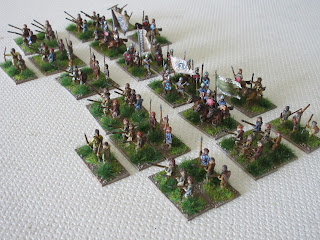Many of our
recent games we have enjoyed using 24 elements for a command, replacing the
standard 12. Increasing the number elements and using one die for pips, approaches
closer to what we read in history; opening skirmishes, concentration of effort against
a particular point, shifting the attack to another area, a lull in battle to
regroup or reform lines.
Rather than
offer another battle report, I will use a recent game between the Fatamid and
Zirid Berbers in Sicily (1067), to illustrate some of the finer points of DBA24.
The
look
Firstly, the
game table is one and a half times larger, resulting in fewer discarded terrain
pieces. In fact, an allowance is mode for an extra optional terrain piece to be
selected by the defender.
The
army
The number
for each troop type listed is doubled, this also allows for two commanders; a
general and one subordinate general, how the latter functions is explained here
in detail. The number of elements forming an allied contingents are also increased.
In this
particular battle, the generals (Cv with flags) can be seen in the second line.
Both sub-generals were lost in game one, creating a critical moment for both
commanders as many troops found themselves beyond command distance. That error
was rectified in game two.
Zirid
army
1 x Ayyub
ibn-Tamin (Cv), 1 x sub-general Ali ibn Tamin (Cv), 2 x Berber lancers (Cv), 6
x Berber light horse (LH), 3 x Berber javelinmen (3Ax), 3 x Black slave
spearmen (Sp), 2 x Arab archers (4Bw), 6 x Berber javelinmen (Ps).
Sicilian
Muslim army
1 x Ibn
al-Hawas (Cv), 1 x sub-general (Cv), 6 x Berber lancers (Cv), 2 x Bedouin
cavalry (LH), 4 x archers (4Bw), 6 x abid al-Shira (4Bd), 4 x Berber archers
(Ps).
One
die used for pips
Some may find
this strange, however, due to the increased number of turns to reach a decision,
good and bad pip scores balanced out. On average, these games were finished
after an average of 8 or 10, twice that needed for a standard 12 element game.
There were some exceptions, such as that of Clovis versus the Alamanni, both warband
armies, which finished in 4.
Deploying
24 elements
You will
discover, moving 24 elements as one groups will become unwieldy, better to deploy
your army into smaller groups, for example a centre, two wings and a reserve. Even
with a bad pip score, one or two of these will maintain the momentum of your
assault. Experience has demonstrated the folly of too many single element
moves, these may become inert as subsequent pips will be needed elsewhere.
More
melees
I can
recall a few standard games were my opponent lost four elements in one bound, thus
ending the game. As armies become locked in combat, the increase in the number
of melees will not necessarily mean more casualties, often more recoils and
even scores will be the result.
This is the
moment when the loss of a general can become critical, as the momentum of an
attack grinds to a halt.
Renew
an assault or look elsewhere?
We have
seen many assaults die as a general could not sustain the momentum, supporting
elements were too far away to be of any use or they were never deployed. Preparation
is key; and moving reserve troops in a timely manner is equally important as
moving front line troops into a subsequent combat. Even better is to use a low
pip score to move a general before troops move beyond command reach.
In our second
game, both sides profited from the previous battle to form fewer groups. The
generals were also better positioned to maintain control over their troops.
Regrouping
scattered units
Approaching
the final stage of the battle, it will become beneficial to regroup scattered
elements and form groups. Reformed troops can improve their chances to renew
combat or maintain the position serving as a deterrent.
On turn
nine, the Zirid army (on the left) used all 6 pips to reform scattered elements
to improve their position and capacity to renew an assault.
Depending
on the mix of troops types, a game can be completed in +/- 45 minutes or two in
an evening.












